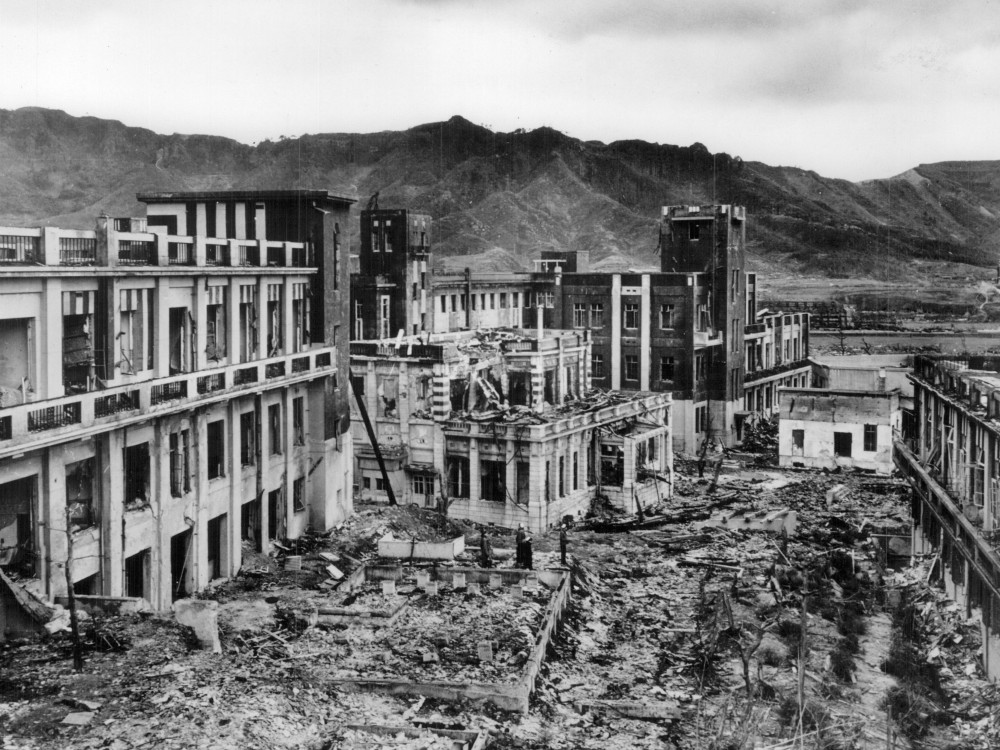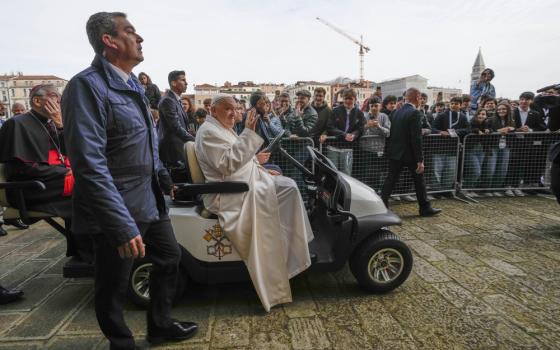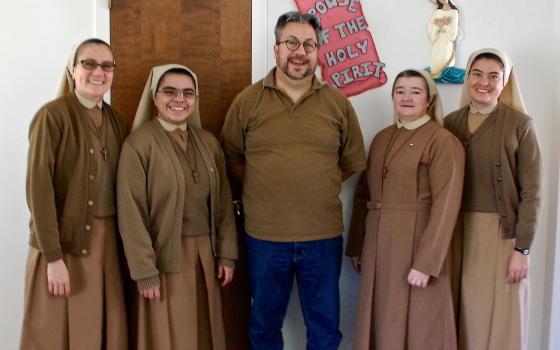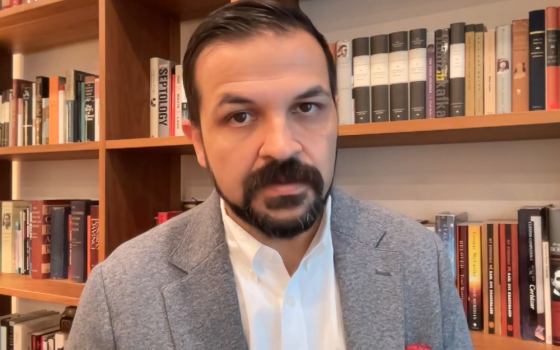
Nagasaki, Japan, is shown four years after an atomic bomb was detonated over the city Aug. 9, 1945. "Hiroshima challenged my faith as a Christian in a way I am only now beginning to understand," the late Archbishop Raymond G. Hunthausen of Seattle said in 1981. "That awful event and its successor at Nagasaki sank into my soul, as they have in fact sunk into the souls of all of us, whether we recognize it or not." (CNS/USA TODAY NETWORK via Reuters/Milwaukee Journal Sentinel files)
In the hours and days following the massacre of an unknowable number of hundreds of thousands of residents of Hiroshima and Nagasaki, Japan, the U.S. Army Corps of Engineers christened it "the greatest scientific achievement in history." President Harry Truman went on the air in grainy black and white to describe it as a victorious "scientific gamble": "We won," he said, simply.
Meanwhile, teams of scientists rushed into the charred remains of the cities to measure the impacts of a blast force strong enough to topple marble gravestones, flip railroad cars, and strip the concrete off a roadway bridge. At the time, 75 years ago, the global public understood very little about the damage atomic weapons could wreak; the U.S. military understood barely more.
We soon had military reports, survey data and an unprecedented surrender by Japan as evidence of the bomb's terrible power. But having never cowered in bomb shelters as fire rained from the air, having never watched a paper city burn in the night, most Americans still lack a frame of reference for the reality of atomic detonation. With help from a well-oiled public relations machine, a mythology of the bomb's scientific might stood in for firsthand experience.
In the years following the destruction of Hiroshima and Nagasaki, no comic book, chemistry set, or cereal box could be sold without some reference to nuclear weapons. The Boy Scouts even introduced a merit badge for atomic energy in 1963.
The volume and intensity of anti-nuclear protests rivaled pro-nuclear propaganda heroically, but within the past 40 years, almost all references to nuclear weapons have vanished from American culture. Anti-nuclear activism has become a fringe interest. Where the bomb ought to be at the fore of the American psyche, in politicians' platforms, in citizen activist networks and ecological grief, you will find instead a flimsy cardboard box labeled "Radioactive: Do Not Open."
Now, another apocalyptic threat justifiably holds activist attention: the ongoing climate crisis. The consequences of runaway industrial activity become more obvious every year, even as focus on nuclear weapons recedes. Both forms of global dying originate in the coupling of earnest science with industrial interest, and both require action at a personal, local and federal scale.
Advertisement
Although the United States is currently set to spend $1.7 trillion modernizing our nuclear arsenal, although our resting nuclear readiness remains almost unchanged from the height of the Cold War, with additional nuclear dangers in the cyber and artificial intelligence realms, Americans have largely swept the issue from our collective consciousness — and thus from our conscience. We can bring the moral question of nuclear armaments back into the mainstream only by recognizing it as fundamentally entangled with our goals for ecological healing.
As the climate crisis threatens every aspect of life, we can observe signs in nature that our biblical forebears might interpret as evidence of disconnection from God: birds falling from the skies, chirping insects falling silent, once-teeming seas pocked with dead zones, algal blooms turning waters red and black.
Christians of European descent have slowly come to recognize ourselves in the burrowing origins of industrial extraction practices, the shift from science to scientism, the disembodied mind's supremacy over the creaturely sphere. We are just beginning to reject the exchange of eternal salvation for Earthly devastation. We no longer crave apocalypse.
Here the climate crisis and nuclear armaments intertwine: The same spiritual values and human limitations that precipitated one also put us at risk of the other. The Enlightenment-era emphasis on objectivity, paired with an American pseudo-millenarian acceptance of apocalyptic ideology, created a cultural engine for weaponizing scientific discoveries with only passing regard for moral, spiritual or ecological implications. And because the risk extends to all life, because our nuclear policy reflects expansion contracts with inhuman corporations, because we are responsible for even the unintended consequences, we must understand atomic effects as features of the capital-driven climate crisis.
After Hiroshima and Nagasaki, testing redoubled in intensity as the United States applied brute industrial force and bombed huge swathes of the American West, the oceans and many sites important to indigenous peoples. Since the first Trinity test in the high New Mexico desert, eight nuclear states have performed 2,053 tests, exploding some 2,476 bombs and blanketing every inch of Earth with radioactive isotopes. Decades of detonations are shrouded in scientific industrial language, away from moral scrutiny.
There is nowhere on Earth you can go to avoid exposure to anthropogenic radioactivity: not the top of a mountain, nor the bottom of a river nor your own bed.
Today, the nuclear payload on a single Trident submarine offers a blast potential equivalent to 40 Hiroshima or Nagasaki explosions — four times the total destructive force deployed in World War II. Nuclear proliferation has been reduced to an inevitable feature of progress.
Every living and future creature is negatively affected by exposure to ubiquitous mutating ionization. The degree of chaotic force exerted on genetic material by radioactivity almost mirrors the theological category of creatio continua. This teaching finds God not in a moment of finite creation, but rather in the Spirit as a principle of indwelling creativity, moving life toward survival through the ability to change, adapt and improve. Nuclear activity holds the exact opposite indwelling force — an enduring ability to make all species less capable of adapting to and surviving in the future world.
There is no data available on how many generations of human beings, frogs, deer, mollusks, insects or bacteria have been or will be affected by exposure to radiation from nuclear testing and waste storage since 1945. There is little data available on how the worst physical and environmental consequences of this testing already harm indigenous nations, Black and brown communities, or non-human life exposed to the waste our current government seeks to deregulate. These are of no concern to our nuclear apparatus.
We do know that there is nowhere on Earth you can go to avoid exposure to anthropogenic radioactivity: not the top of a mountain, nor the bottom of a river nor your own bed. And we know the same communities most threatened by climate catastrophes are also plagued by birth defects and novel cancers from byproducts of testing and storage.
In 2020, with so many other encroaching crises, all these consequences are pasted over in nuclear discourse by two words: We won. Seventy-five years after that first scientific gamble, as our military expands our nuclear might, our political leaders move to relax safety standards in poor and rural areas, yet most Americans consider the nuclear age a thing of the past.
We must, as people of faith, rise to disarm and neutralize the American nuclear arsenal with the same intensity with which we fight for the continuing ability of all God's creation to survive, adapt and improve, not in the great eternity, but here, in this realm and on this Earth.
[Christina Ellsberg has a master's degree in social ethics and systematic theology from Union Theological Seminary and is currently pursuing a doctorate in religion and modernity at Yale University. Ellsberg also holds a position on the board of the Women's Ordination Conference.]






